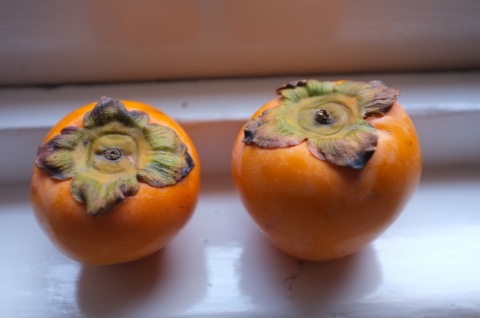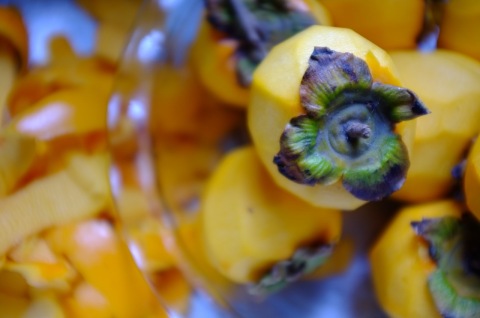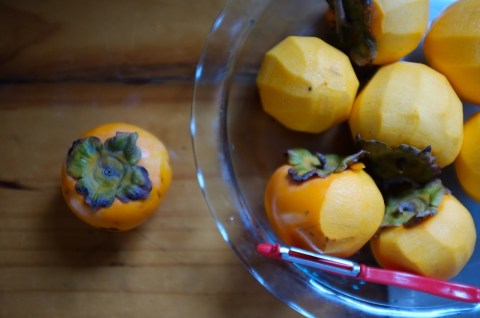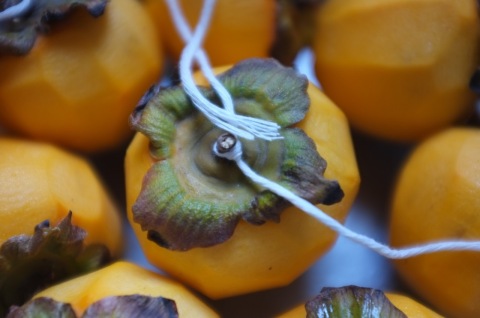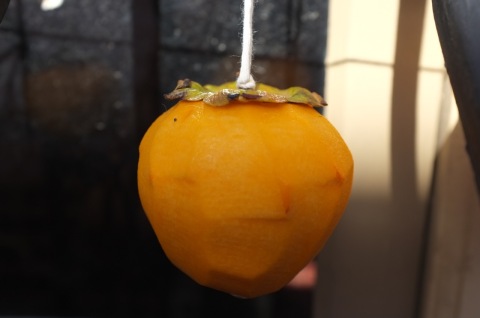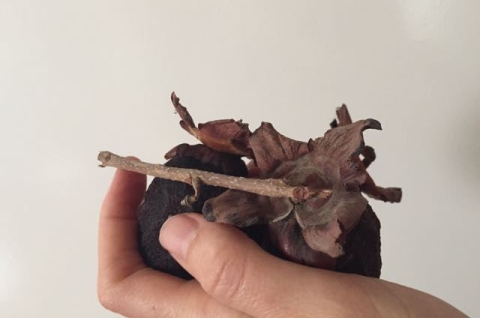snake beans
July 15, 2013 § 2 Comments
The Tropical Garden Spectacular was on a few weeks ago. At the botanical gardens under trees with impossibly huge canopies I watched some local food cooking demonstrations. Lined up on straw bales with the green grass at our feet, some glimpse of paradise on the warm breeze, the chef Selvam Kandasamy from Saffrron, taught a small group of us how to make snake beans, sautéed in spices with coconut and curry leaves. And this my dear friends is a dish to be celebrated.
Snake beans are the lanky tropical equivalent of the green bean and you would be forgiven for thinking them somewhat tough and woody with little flavour. This recipe however does them justice. It is full of flavour, crunchy, slightly sweet, bright green and turmeric yellow. The coconut and chili melts on your tongue. The intermittent curry leaves are bright in your mouth. The beans are cooked hot in a wok for just the very right amount of time making them softly crunchy and fluorescent.
I have made this recipe many times since then and each time I have continued to love it. It is similar to the original made by Selvam Kandsamy except I have used coconut oil instead of peanut oil.
Spicy Snake Beans with Coconut and Curry Leaves
Serves: 4 – 5 as a main or 6 – 8 as a side dish.
Note: If you are in distant and cooler parts wanting to use something more locally appropriate I am sure green beans would also make a good substitute.
3 Tbsp pure coconut oil
2 flat tsp brown mustard seeds
2 flat tsp turmeric
1/2 tsp salt
1 red onion finely diced
1 whole fresh red chillis (you can also use 1 tsp dried chilli flakes instead)
1 Tbsp Split yellow lentils (optional)
4 cups chopped snake beans
1/2 cup shredded coconut
A good handful fresh curry leaves
Extra salt to taste

Prepare all your ingredients before hand. Once you start cooking it all happens fast.
In a wok heat the oil on a medium to high flame until hot. Add the mustard seeds, turmeric, onion, and salt. Stir until the onions turn just translucent, then add the chilli and lentils. Continue stirring and add the beans and coconut stirring until the beans are just cooked through but still have a crunch and are bright green. Add the curry leaves and remove from heat.
It is lovely served as a side to fish or on its own with brown rice.
I hope you like it as much as I do.
the story of how I learnt to make yoghurt
May 18, 2013 § 3 Comments
The story of how I learnt to make yoghurt is not a simple one. It spans some 5 years and two continents. It begins just after I finished my undergraduate degree, when I spent a year in India, getting lost and trying to find myself again. As you do when you are 24. During that time, I spent a couple of months volunteering in a Buddhist nunnery teaching English in the Gompa. The nunnery was in the far north of India, in a place called Zanskar, a mountain range that runs on the Tibetan side of the Himalayas. Being in the rain-shadow of the tallest mountain range in the world, Zanskar is something like a desert, it never rains and vegetation on the surrounding slopes is scarce. But in the valleys where there are glacial streams, fluorescent green fields make a stark contrast to the moonscape hills. Here the grass grows with a certain urgency learnt through evolution in a land where warmth and water are ungenerous.
But signs of life are not restricted to the stream soaked valleys. On the hill tops prayer flags beat in the winds, some are very old, worn and tattered with almost all their prayers lifted to the breeze. Fossils scatter the myriad of paths that weave their way out of town along scree slopes and over mountain ridges. These benthic remnants a reminder that this very landscape was once hundreds of meters below the ocean.
My journey to Zanskar begins in Leh, with a 26 hour bus ride covering some 400km to take me to the remote valley. As you can imagine, the road is very rough. Because I booked late, I don’t have a seat and so have to make do with the floor where I wedge my way into a somewhat comfortable space between the luggage that fills the aisle. I am not the only one and soon a man falls asleep on my back and another on my knees. After 10 hours of this and with the knowledge of 16 more to go, I begin to feel agitated, my legs and back cramped. From my place on the floor I glance up at a boy standing at the front of the bus without even room to sit. He is smiling and in his smile my anger subsides. The easy nature of the locals and their open acceptance of each situation is contagious. Like other times when I have traveled to developing countries, I am struck by what lessons we have forgotten in a privileged and wealthy world. Not long after, a girl sitting on the seat next to me offers me her lap to rest my head. Gratefully I fall asleep there for an hour or two. Later I find out she is from Zangla, the small village where I will be teaching.
When we finally arrive, tired and dirty from the dusty road, it is late, so I spend the night with the girl from the bus in her family home. Their house is like all the rest in the village, made from mud and cow dung, two stories high, with a flat roof loaded with fodder, wood and dried cow dung to burn in the coming winter.

The next morning I walk through a flowered field woven with a myriad of creeks and streams running to the river. There I wash in water clear as glass before walking the short distance to the Gompa that sits on a small hill on the far side of the village. I am nervous to meet the nuns as they have no way of knowing I am coming, but I am greeted with warm smiles and open laughter.
During my time at the monastery, my relationship with the nuns becomes more like a friend than a teacher and maybe this is why at times it is difficult to get them to come to class. Many of the nuns don’t have much of an interest in learning English, except maybe male and female body parts for which they have abundant enthusiasm. But it makes me question what I am doing. What is the purpose of teaching English? Is it not just another form of cultural imperialism? I still don’t really know the answer to this, but I do know that I am there with others who came before and after me. With a growing number of tourists visiting the region each year and with increasing access to the outside world, western influences are unavoidable. And in general, such change is welcomed by the locals, because with it comes a higher standard of living, the ability to join the rest of the world, to “develop”, to “progress”. I realise I am more sentimental than many of the locals in regard to the loss of traditions and the damage to land and culture that comes with such pursuits. But as I learn from the Buddhists that live there, nothing is permanent, change for good or for bad is inevitable. So perhaps as westerners we should focus on learning from our own mistakes and try to assist those who are following in our footsteps to take on a more sustainable path. Because of this I allow myself some small reassurance that in some tiny way, I am giving the nuns some of the skills they need to communicate with the outside world, so they can speak up and voice their needs and concerns in a shifting landscape. But it is small comfort in light of the stories of rapidly retreating glaciers, water sources drying up, the brain drain as educated children chose to live in far off cities, the introduction of white flour, sugar, packaged food and the plastic litter building up in a place with no formal rubbish disposal system.
So I spend my time practicing the art of just being and trying to help where I can, teaching in the school with the younger nuns, offering small informal English lessons here and there and lending a hand with the cooking.
The kitchen is a good place to be because it is where the nuns meet. Warm and cheeky they laugh and hoot slapping one another on the legs as they sit cross-legged at the low tables lining one wall of the large room. This is where I watch them making yoghurt. Taken fresh, straight from Pashi the Gompa’s resident cow, they heat the milk over a large pot-bellied stove in the middle of the room. Just as the milk starts to simmer but before it boils they pull it off the heat allowing it to cool to the temperature of a hot bath before stirring in a tablespoon or so of yoghurt left over from the last batch. The whole pot is then wrapped in a thick woollen blanket and placed in a corner of the kitchen until the next day when it is eaten with ladakhi bread and butter tea for breakfast.
I become very fond of Pashi and her calf Patel. They are a handsome pair, golden blond with strongly defined features. Their stable is next to my room and at night I can hear them moving around. They give me great comfort. In the evenings I bring Pashi back from the fields where she is tethered on a grassy knoll. The pleasure in the simplicity of it all, walking the cow home with the summer breeze on my face and playing in my skirt.
My room is also made of mud and cow dung, a little square that I can just lie down in. It has a small window and a small door I have to double over in to enter. When it is windy the roof sprinkles dirt to the floor. The scene from my window is vivid. At dusk small birds with round bellies and orange tails sit outside and I try to be very quiet then, any movement and they will fly away. As night draws, the moon illuminates the land with a pale yellow grey light and the shadows of the clouds play on the mountain tops.
Some days I walk to the river, its fast current tempting me, full of the energy of the mountains and sky from which it came. To get there I walk past Mane walls, ancient inscriptions on flat stones piled together. Who placed those first rocks there sending Om Mane Padme Hum to all ends of the earth? The valley big and broad with barely any landmarks, I lose perspective of distance, everything seems closer than it really is. Zhos (a cross between a yak and a cow) graze on the fertile strips where a creek meets the river’s edge. I watch the herders bring them together and drive them home. At the river the current is hypnotising, eddies run in all directions and waves appear to move upstream.
Other days I follow the small stream up behind the Gompa into a canyon that becomes narrower and narrower drawing nearer to its source. There in the rock pools I swim comfortably naked and alone among the pastel green, maroon, and orange of the boulders. The water as glass, streams crystal clear over the rocks, like cloth falling over the landscape, cool enough to make me gasp but warm enough to linger a while.
One night stands out to me in particular. It is nearing the end of my time in Zanskar when we can’t find Pashi. She is not in the field where we left her and must have broken her tether. One of the nuns and I go looking for her down by the river. The moon is half full in the sky and bright enough to lead the way, the stars half obscured by clouds. The green field in the flat of the river runs with small streams and shines moist. The beauty catches my breath. We spend two hours wandering along the water’s edge, through fields and along stone-walled pastures. Finally, defeated, we walk back to the village through the sweet smell of mustard in flower. Back at the Gompa we find Pashi tethered to her stable. One of the other nuns found her and brought her back whilst we were gone. By now it is late and I climb back into my mouse-hole room only to find I cannot sleep. The freshness of the night still on my skin and in my mind, the stars shining on me.
My last day in Zangla, I wake up from my small window to see the sun’s first rays on the fresh snow-capped mountains turning from grey to orange to yellow and finally to white as the day begins. My sleeping bag is slightly wet from rare rain that fell that night. After breakfast the nuns fill my bag with chapatis’ for my journey to Leh. Way to many for me to eat by myself but they insisted I take them all. We hear the bus coming so running out the door, kataks thick around my neck it finally dawns that I am leaving and tears prick my cheeks. I climb onto the roof of the bus. From there the nuns look so sweet waving in their maroon robes framed by the Gompa and the Himalayas. The fresh morning and the smiling mountains feel good on my damp cheeks. I am full with the privilege to have lived a little in their world.
How to make Yoghurt
Before going to Zanskar, I had always been put off by the idea of making yoghurt as every recipe I had come across called for either a yoghurt-maker or thermometer, making it all seem far to complicated. But after seeing the nuns do it, I realised all you really needed was a large pot, a warm place, a blanket and a bit of careful watching.
But still I kept putting it off and it wasn’t until a year ago when I was asked to give a fermentation workshop at CERES that I decided I better give it a go. I couldn’t even pretend to be an expert if I had never made yoghurt before. So I started researching. It turned out I didn’t need to go far. In my bookshelf was my much-loved copy of Wild Fermentation and in it a recipe for Yoghurt that doesn’t use a yoghurt maker or a thermometer. This was what I’d been waiting for.
The most important thing you need when making yoghurt is a warm and cosy place to rest it in. I usually pre-heat a small Esky by filling it up with hot water from the tap. I then empty it, dry it out and fill it with towels and if it is winter and really cold, a hot water bottle or some jars filled with warm water as well. But really what you need is a place that will cool down very slowly. I have also heard of people making yoghurt in a thermos and I’m sure this could work too.
Yoghurt Recipe makes 1 litre
Equipment
1 litre jar
Insulated cooler/esky
Ingredients
1 litre whole organic milk
1 Tbsp fresh yoghurt (check it has live cultures)
Method
Pre – heat your jar and cooler with hot water, so that they won’t drain heat once you pour in your yoghurt.
Slowly heat your milk, paying close attention, until tiny bubbles start to form but before it starts to boil (if you have a thermometer, this is 80°C/180°F). Stir frequently to avoid burning the milk. The heating is not absolutely necessary, but it helps to get thicker yoghurt.
Allow the milk to cool until it still feels hot but is not so hot that you can’t keep a clean finger in it. You can quicken the cooling process by placing your saucepan in a bowl of cold water. But be careful it doesn’t cool too much. The optimum temperature is as mentioned above – about 40°C/110°F).
Mix the starter yoghurt into the milk. Make sure you don’t get tempted to add more yoghurt thinking it will help to make a thicker end result as it will do the opposite. Poor into your jar, screw on the lid and place in your pre heated “incubator”. If you see fit, add some jars with warm water and/or a hot water bottle (with warm water in it) to help maintain the temperature. Leave in a place where it won’t be disturbed as it doesn’t like being jostled.
After 8 – 12 hours, check on your yoghurt. It should have developed a “tangy flavour and some thickness” .
Store in the fridge and consume within 4 weeks, saving some for your next batch.
Finally, make sure you have a look at how to make Labnah cheese from yoghurt here and some of the things you can do with Labnah here.
humble beginnings
March 11, 2013 § 2 Comments
Our new life is settling into itself. A bed has been made out of scrap wood from the recycling centre, a portable oven found in our land lords shed, a table, two chairs, a fridge and no job!… yet.
There is something rather fragile and strange about things when they are just beginning. A humble recipe of uncertainty, insecurity, space to be reflective, waiting, letting go, anticipation, and in this case, much time left to watch the rain. And boy does it rain, heavy thunder on our roof.
The first thing I felt like cooking when I arrived in Darwin were these Oatcakes – probably for their comforting nature. They are halfway between a cracker and a biscuit being both salty and sweet, they are incredible with cheese and even better with a sip of red wine when there is something to celebrate. I found the recipe at Molly Wizenberg’s very enjoyable and always inspiring blog Orangette. Apart from her recipes and beautiful photos, I think what I enjoy most is the honesty in her writing and the courage this takes.
Rather than re-write her recipe I am just going to send you over to her website which you can do by clicking here.
xx
spiced roast eggplant and zucchini salad
January 13, 2013 § 1 Comment
It is hot! Stinking hot! The kind of heat with thick hairdryer winds. The kind of heat you feel like you are swimming in rather than walking in. The air is viscous, your arms almost float in it.
I never feel like eating much in this weather other than ice cubes, salads and smoothies. Not all at once of course but spaced between episodes of gasping on the couch with a wet towel on my head and the fan on high no less than two feet from my face.

The recipe below for an eggplant and zucchini salad spiced with paprika, cumin and mint, is both light and rich. The dried figs, walnuts and fetta add a lovely texture to the softness of the roasted vegies.
Spiced roast eggplant and zucchini salad
2 – 3 large eggplants
1 large or 2 small zucchinis
Salt
1/3 cup olive oil
2 Tbsp apple cider vinegar
1 Tbsp honey
1 tsp paprika
1/2 tsp cumin
4 cloves garlic chopped
Zest and juice of 1 lemon
Juice of half an orange
1/2 Tbs tamari or soy sauce
1 cup fresh mint leaves roughly chopped
1/2 cup dried figs roughly chopped
3/4 cup toasted walnuts roughly chopped
1 cup roughly chopped crumbled fetta


Preparation
Preheat oven to 200°C /400°F
Cut the eggplant and zucchini into 1-inch cubes and put in a large bowl. Sprinkle lightly with salt and set aside for about 15 minutes or until juices start to come out of the eggplant. Rinse in cold water, drain and pat dry.
In the meantime, combine olive oil, vinegar, honey, paprika, cumin, lemon zest, half the lemon juice and chopped garlic. Stir into the salted and washed eggplant and zucchini.
Spread the mixture onto a large baking paper lined baking dish and roast in the preheated oven for 45 minutes, or until very tender and browned. You will need to check on them and give them a toss halfway through the cooking. Remove from the oven and allow to cool slightly.
Place roasted veggies in bowl and add tamari, orange juice and the last half of the lemon juice. Toss. Stir in the mint, figs, walnuts and feta and enjoy.
Serves 4
hello 2013
January 4, 2013 § 2 Comments
I was camping at the Grampians for new years, watching birds and stars, climbing mountains and drinking lots and lots of tea. It was such a peaceful way to start 2013, and I feel like this year is going to be great! It is just a feeling, which is perhaps more important than any materialisation of the thought, but that’s ok too.
This festive time of year always makes me think of my mum and her bean salad. It often ends up on the table on special occasions and Christmas and new years are no exception.
As easy and very simple dishes often are, this has always been one of my favourites. This year however, I have started making it with some fresh apricots chopped up and thrown in too. There is something lovely about the tartness of the vinegar with the sweet freshness of the apricots and the greenness of the beans and basil. Below, I have put mum’s recipe but feel free to add some apricots if you would like.
Mum’s Green Bean Salad
2 huge handfuls of green beans
A splash of olive oil
A few splashes of balsamic vinegar
A good sprinkle of sea salt
A very good handful of roughly chopped basil
Top and tail beans, cut in half and steam until fluorescent green and crispy. Take off the heat and rinse in cold water to stop the cooking. Whilst the beans are still warm add the olive oil, vinegar and salt and mix in. Once the beans are cool add the basil.
This salad can be served straight away or left to marinate for a couple of hours and served at room temperature.
there’s time
October 24, 2012 § 7 Comments
Hello…
Well, I made it. I am on the other side of something quite big, something that has kept me rather distracted from myself and all the other things I have wanted to do for the past two years. I have finished my masters! And there is a very peaceful knowledge that time is now on my side. It belongs to me again. This is nice. Well very nice actually. Overwhelmingly fantastic!
So here I am with some space, to do something for myself, slowly and how ever I want to. Thats a lovely feeling.
The garden is caught between winter and summer and remains positively neglected and wild. But, this is not so bad, because I know that it doesn’t have to be that way.
Its wonderful to know I can now spend more time taming broad beans, if thats what I want to do. But perhaps more importantly, more time nourishing my wicked taste for very fine delicious things.
Thanks to a very delicious breakfast eaten here and to Jamie Oliver for the idea for this recipe.
Smashed Broad Beans and Peas
2 cups fresh podded broad beans
1 cup fresh podded peas
a decent handful of fresh mint
a decent couple of splashes of olive oil
juice of one lemon
about 1/4 of a garlic clove crushed
Salt and pepper to taste
Cook the peas and beans in boiling water for no more than two minutes, drain and rinse in cold water immediately. Pull the outer skin of each podded broad bean – and puree all ingredients together.
Its that easy
Serve on toast with a poached egg and a smattering of finely grated pecorino.
kimchi
September 30, 2012 § 2 Comments
Here is a vegetarian version of kimchi, a korean type of sauerkraut. I have had a craving for this for a while now, so yesterday I headed on down to the CERES market to pick up the ingredients .
What you will need
6 cups shredded cabbage
2 cups grated carrot
2 cups grated daikon radish
1 Tbsp grated ginger
2 cloves crushed garlic
1/2 – 1 tsp chilli flakes or chilli paste
1 Tbsp Salt
4 Tbsp Tbsp whey (or alternatively use an extra 1 Tbsp salt)
Place all ingredients in a very large ceramic or glass bowl. Pound with a heavy spoon, potato masher, or a meat hammer to release the juices. Sterilise, a wide mouthed 2 liter jar. Place the pounded ingredients inside the jar and push down firmly so there is a layer of juices above the vegetables. There should be at least 1 inch between the top of the jar and the vegetables. Cover tightly and leave at room temperature for 3 days before transferring to the fridge. You can eat straight away, however it will improve after another week or so.
quinoa pancakes
July 8, 2012 § 7 Comments
I have been eating a lot of these lately, drizzled with maple syrup, fresh grated pear and creamy yoghurt. Its a lovely way to start these cold days. Pretty healthy too given that they are gluten free and full of protein. Instead of using buckwheat flour you can add double the amount of almond meal or vice versa. Up to you!
Recipe for quinoa pancakes
3/4 cup quinoa
1 1/4 cups water
2 eggs
1/4 cup almond meal
1/4 cup buckwheat flour
1/2 cup additional water
1 tsp baking powder
First you will need to cook the quinoa: Rinse and drain the quinoa and then place in a saucepan along with 1 1/4 cups water. Bring to the boil and then reduce to a simmer until all the water is absorbed and the grains are soft, much like you would cook rice.
Allow to cool before adding all the remaining ingredients including the additional water. Beat with a fork or whisk until you have a fluffy and well combined batter.
Cook as you would any pancakes in a heavy based greased frying pan, over a medium flame and tilting once you have added the batter to help it spread a little. Cook until golden brown on both sides.
Have a lovely day…
xx
Oma’s cabbage
May 18, 2012 § 6 Comments
I grew up with this recipe but never learnt to like it until recently. Passed down from my flemish heritage its great on premature winter days like this one. Served by my Oma and mother the traditional way with sausages and potatoes makes a warming dinner. A more recent discovery of mine is having the leftovers on toast with a poached egg and chutney.
Recipe for Red Cabbage with Apples
1/4 cup water
1/2 red cabbage sliced
1 Tbsp brown sugar (optional)
Salt to taste
A handful of pitted prunes
2 apples sliced and cored
A good few splashes of apple cider vinegar (about 1/6 cup)
Place the water, cabbage, sugar and salt in heavy-based (and if you have it oven proof) saucepan. Cook very gently using a simmer mat for about 1 hour. Add the prunes, apple and vinegar. Either place in a pre-heated oven or continue on the stove top until the apples are soft but not completely mush.
Stay warm

